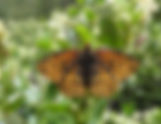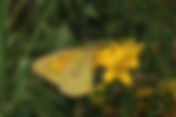181 results found with an empty search
- Butterflies of Oregon | Photos • Identification • Biology
Butterflies of Oregon has exquisite photos and information about all of Oregon's native butterfly species, covering the identification, distribution and biology of each species. A lively blog provides seasonal stories and updates from the field. Butterflies of Oregon Welcome to Butterflies of Oregon, a resource for Oregon butterfly enthusiasts, with photos of all of Oregon's regularly occurring butterfly species and information to help you find and identify them. Butterflies of Oregon also shares stories of the author's attempt to photograph all of Oregon's butterfly species in the wilds of Oregon. Thanks for visiting! www.butterfliesoforegon.com Subscribe to Blog Thanks for submitting! Email Us
- Lupine Blue | ButterfliesofOregon
Photos, flight season, distribution and host plant information, conservation status, and identification tips for the Lupine Blue butterfly. Gallery Prev Next Frissell Ridge, Lane Co, July 18 - male Lupine Blue Icaricia lupini Size: 1.0 - 1.25 inch wingspan Key ID features: Male blue above with narrow black marginal band and white fringe, on HW red-orange band above marginal row of black spots, often with narrow darker band between orange and blue. Female brown above with darker marginal line and white fringe on FW, on HW broad orange band above row of dark brown marginal spots. Below, male light bluish gray, female brownish gray, with black spots. HW has row of marginal spots that are black inwardly, then orange, and outwardly black with a circle of iridescent blue. Similar species: Acmon Blue very similar, but tends to be smaller, and on males, tends to lack dark border between pinkish-orange band and blue on HW above. Note shorter flight season of Lupine Blue below. Host plant: Several Buckwheat (Eriogonum ) species . Habitat: Wide range of habitats, from sea level lowlands to montane habitats. Range: Found in all of eastern Oregon and SW Oregon and on Rickreall Ridge in Polk County. The high elevation segregate (AKA Volcano Blue) is found in high elevation pumice habitat near its host plant, Shasta Buckwheat. Season: Late May to early August Abundance: Common Conservation Status: Secure
- Golden Hairstreak | ButterfliesofOregon
Photos, flight season, distribution and host plant information, conservation status, and identification tips for the Golden Hairstreak butterfly. Gallery Prev Next Lost Lake, Linn Co, August 19 Golden Hairstreak Habrodais grunus Size: 1 - 1.25 inches wingspan Key ID features: Above golden brown with darker edges on FW. Below tan with indistinct brown bands. Short tails on HW. Similar species: There are no similar hairstreaks in Oregon. Host plant: Golden Chinkapin (Chrysolepis chrysophylla ). Habitat: Dry sunny slopes with Chinkapin. Range: Cascade Range, Siskiyou Mtns, Klamath Mtns. Season: Early July to late September Abundance: Locally common Conservation Status: Secure
- Hedgerow Hairstreak | ButterfliesofOregon
Photos, flight season, distribution and host plant information, conservation status, and identification tips for the Hedgerow Hairstreak butterfly. Gallery Prev Next Crooked Cr, Lake Co, August 6 - female Hedgerow Hairstreak Satyrium saepium Size: 1.0 - 1.25 inches wingspan Key ID features: Coppery-brown above. Gray-brown below (darker when very fresh) with broken median line, and vague submarginal band of black chevrons on HW. Relatively short tails, with blue frosted patch just below. Similar species: Somewhat similar to Mtn Mahogany HS, which is more gray or gray-frosted over brown below. Gold-Hunter's HS has a less clear and less defined median line on HW below, and has a very restricted range. Host plant: Ceanothus species, including C. cuneatus (Buckbrush), C. velutinus (Snowbrush) and C. integerrimus (Deerbrush) . Habitat: Shrubby hillsides and canyons, oak scrub, chaparral where host plants grow. Range: NE Oregon, SW Oregon, Cascade Range. Season: Mid-May to late September Abundance: Common Conservation Status: Secure
- Two-tailed Swallowtail | ButterfliesofOregon
Photos, flight season, distribution and host plant information, conservation status, and identification tips for the Two-tailed Swallowtail butterfly. Mack's Canyon Boat Launch, Sherman Co, April 30 Gallery Prev Next Two-tailed Swallowtail Papilio multicaudata Size: Over 5 inches wingspan Key ID features: Very large. Upperside mostly yellow with wide bands of yellow on forewing separated by black lines, extra tails, blue chevrons on black band near hindwing margin. Below, very similar to above, with red-orange shading in yellow marginal spots near the tail. Similar species: Western Tiger Swallowtail is smaller and has broader black bands on forewing and single tails. Host plant: Primarily western choke cherry (Prunus virginiana var. demissa). Habitat: Riparian and road corridors, canyons and urban parks and gardens. Range: Throughout eastern and southwestern Oregon. Season: Late March - mid-September Abundance: Common Conservation Status: Secure
- Compton's Tortoiseshell | ButterfliesofOregon
Photos, flight season, distribution and host plant information, conservation status, and identification tips for the Compton's Tortoiseshell butterfly. Gallery Prev Next Oregon State Arthropod Collection #0001093061- male Thank you to Dana Ross and Paul Hammond , volunteers at OSAC! Compton Tortoiseshell Nymphalis l-album Size: Up to 3 inch wingspan Key ID features: FW above rusty orange with black patches, dark mustard yellow border and marginal band with black line between. HW brown with broader mustard bands, and white bar at leading edge with dark patches on each side. Below two-toned brown or gray, with darker inner half and lighter striated outer half, blue-gray submarginal band. HW below with flattened silver "v," sometimes reduced or absent. Similar species: Above, white bar on leading edge of HW is unique. Host plant: Birches, willows, and aspens . Habitat: Typically found along streams in forested areas, and in mountain canyons. Range: Wallowa Mtns, and far NE Blue Mtns . Season: Early March to mid-October. Abundance: Scarce, may not breed in Oregon every year. Conservation Status: Secure
- Pale Crescent | ButterfliesofOregon
Photos, flight season, distribution and host plant information, conservation status, and identification tips for the Pale Crescent butterfly. Gallery Prev Next Gert Canyon, Wasco Co, May 4, male Pale Crescent Phyciodes pallida Size: Up to 2 inch wingspan Key ID features: Above, orange patches and bands separated by black, much lighter in males. FW fringes checked, HW fringes white. HW above with submarginal band of small black dots circled with orange. Males especially have squarish black bar at middle of FW trailing edge above . Below white, tan and brown bands and patches. Similar species: Pale Crescent is larger than Field or Mylitta. Mylitta lacks squarish black bar at trailing edge of FW above. Host plant: Thistles including Cirsium undulatum . Habitat: Dry foothill gullies, streamsides and canyons. Range: Lower Deschutes River basin, Snake River basin . Season: Mid-April to early August Abundance: Common Conservation Status: Secure
- Sagebrush Checkerspot | ButterfliesofOregon
Photos, flight season, distribution and host plant information, conservation status, and identification tips for the Sagebrush Checkerspot butterfly. Gallery Prev Next Big Indian Gorge, Harney Co, June 20 - male Sagebrush Checkerspot Chlosyne acastus Size: Up to 1.75 inch wingspan Key ID features: Male above, bands of pale orange and yellow-orange, separated by black lines, crescents and checks . Basal 1/3 of HW above sometimes black with little orange. Male often lighter than female above. Below bands of chalk-white and brick red with black veins and edges. More white below than other similar species. Similar species: Northern Checkerspot darker above, and with off-white rather than white below. Host plant: Several species including green rabbitbrush (Chrysothamnus viscidiflorus ), gray rabbitbrush (Ericameria nauseosa ), desert yellow fleabane (Erigeron linearis ) and asters in the genus Dieteria . Habitat: Sage desert, pinyon-juniper savanna, washes, gulches, canyons and brushy flats. Range: Mostly below 5000 feet in SE Oregon deserts, and below 3000 feet in Columbia and Snake r iver basins . Season: Late April to late June Abundance: Common Conservation Status: Secure
- Great Basin Wood Nymph | ButterfliesofOregon
Photos, flight season, distribution and host plant information, conservation status, and identification tips for Great Basin Wood Nymph. Gallery Prev Next Picture Rock Pass, Lake Co, Aug 5 Great Basin Woodnymph Cercyonis sthenele Size: Up to 2 inch wingspan Key ID features: Above, brown or gray-brown with two eye spots on FW, lower eye slightly smaller, otherwise plain. Below, silvery striated brown with one to several small eyespots on HW, two large eyespots on FW (lower one smaller as above), but nearly equidistant from FW margin. Dark median line below lobed, but smoother than in Small Wood Nymph. Similar species: Small Wood Nymph is smaller, and HW median line below is more erratically jagged. Host plant: Undetermined grass species . Habitat: Sage-steppe, bunchgrass prairie, pinyon-juniper stands, ponderosa pine lands, oak-lined canyons. Range: Eastern Oregon, Siskiyou Mtns, Cascade Range from Lane County south. Season: Late June to late September Abundance: Common Conservation Status: Secure
- Orange Sulphur | ButterfliesofOregon
Photos, flight season, distribution and host plant information, conservation status, and identification tips for the Orange Sulphur butterfly. Gallery Prev Next Upper Mule Prairie, Lane Co, August 2 - male Orange Sulphur Colias eurytheme Size: 1.3 - 2.3 inches wingspan Key ID features: Males above, bright orange with unbroken black border. Females above either bright orange or greenish white with "window" spots breaking up black border. Below, central pearly "discal" spot on HW with small satellite spot, and two pinkish-brown rings, and submarginal row of black or brown "eurytheme spots." Similar species: Western Sulphur and Clouded Sulphur are lemony yellow, lacking orange. White females difficult to separate from Clouded Sulphur, but often HW border is stronger in female Orange Sulphur. Host plant: Many species in the pea family. Habitat: Most commonly seen in meadows, pastures, fields and other open habitats. Range: Throughout Oregon Season: Late March to early November Abundance: Common Conservation Status: Secure
- Indra Swallowtail | ButterfliesofOregon
Photos, flight season, distribution and host plant information, conservation status, and identification tips for the Indra Swallowtail butterfly. Gallery Prev Next Illinois River Rd, Josephine Co, April 24 Indra Swallowtail Papilio indra Size: 2.25 - 2.5 inches wingspan Key ID features: Upperside mostly black with narrow band of yellow on forewing, stubby tails, blue patches on black band near hindwing margin. Underside almost identical to upper side, with paler black. Similar species: Anise Swallowtail has much less black on forewing and longer tails. Host plant: Wild members of the parsley family. Habitat: Dry canyons, riverbanks and roadsides, hilltops, rocky desert washes. Range: Blue Mtns, northern portion of Cascade Mtns on east side, Steens Mtn, and Klamath Mtns. Season: Late March - mid-August Abundance: Uncommon Conservation Status: Secure
- Hoffman's Checkerspot | ButterfliesofOregon
Photos, flight season, distribution and host plant information, conservation status, and identification tips for the Hoffman's Checkerspot butterfly. Gallery Prev Next Bachelor Mtn, Linn Co, July 13 Hoffmann's Checkerspot Chlosyne hoffmanni Size: 1.25 to 1.75 inch wingspan Key ID features: Above, bands of orange and yellow-orange, separated by black lines and patches . Median band usually lighter. Basal 1/3 of HW above is mostly black with little orange. Below bands of off-white and brick red with black veins and edges. Red spots in postmedian band often longer than in similar species. Similar species: Northern Checkerspot often does not have the large black area on the basal HW above, and below post-median band spots are generally shorter than in Hoffman's. On Northern Checkerspot, the orange patches on the dorsal forewing are more distinct and smaller. On Hoffmann's, the orange bars in the middle of the forewing are much longer, and often have a "smeared" look, a gradient of shades of orange. Hostplant: Asters, including western showy aster (Eurybia conspicua ) and Cascade aster (Eucephalus ledophyllus ) . Habitat: Moist montane meadows, canyons, streamsides, clearings in conifer forests. Range: Cascade Range above 1000 feet. Season: Early May to early September Abundance: Common Conservation Status: Secure











